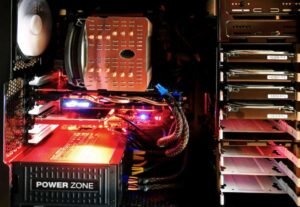Giga Factory in Nevada
Nevada’s Giga Factory, owned by Tesla, Inc., is an enormous manufacturing plant dedicated to the production of electric vehicle components and batteries. With its vast scale and advanced technology, it has revolutionized the automotive industry by accelerating the adoption of electric vehicles worldwide.
Key Takeaways
- The Giga Factory in Nevada is a significant milestone in the production of electric vehicle components and batteries.
- Tesla’s Giga Factory has contributed to the global shift towards sustainable transportation.
- The factory showcases advanced manufacturing techniques and cutting-edge technology.
- It has brought job opportunities to Nevada and boosted the state’s economy.
**Spanning over 5.3 million square feet**, the Giga Factory in Nevada is one of the largest buildings in the world **and aims to produce sustainable and affordable energy solutions** for Tesla’s electric vehicles. Located in Sparks, Nevada, the factory’s construction began in 2014 and has been continually expanding since then. The factory plays a crucial role in Tesla’s mission to accelerate the world’s transition to sustainable energy.
**One interesting aspect of the factory is its commitment to renewable energy**. The Giga Factory houses a massive solar array on its rooftop, which helps to power the manufacturing process with clean, sustainable energy. This integration of renewable energy sources showcases Tesla’s dedication to reducing its carbon footprint and leading by example in the realm of sustainable manufacturing.
Factory Operations and Impact
The Giga Factory in Nevada operates with a goal to **establish vertical integration** within Tesla’s manufacturing process. **By bringing the entire battery production in-house**, Tesla reduces its reliance on third-party suppliers and gains more control over the quality and cost of its components. This optimization allows Tesla to maintain competitive pricing and deliver high-performance electric vehicles to consumers.
*Tesla’s Giga Factory has been instrumental in driving down battery costs and making electric vehicles more affordable for the masses.*
The factory employs a wide range of innovative manufacturing techniques, such as **advanced automation and robotics**, to streamline production and enhance efficiency. **The factory operates 24/7** and has a planned annual battery production capacity of 35 gigawatt-hours as of 2020, which is expected to increase significantly in the coming years.
Impact on Nevada
The establishment of the Giga Factory in Nevada has had a transformative effect on the state’s economy. It has *created thousands of jobs, fostering economic growth and diversification*. The factory’s presence has attracted other businesses and investments to the region, further boosting the local economy.
The following tables provide some interesting data regarding Tesla’s Giga Factory in Nevada:
| Year | Number of Jobs Created |
|---|---|
| 2014 | 2,900 |
| 2017 | 7,059 |
| 2020 | 10,215 |
| Year | Annual Battery Production Capacity (GWh) |
|---|---|
| 2016 | 20 |
| 2018 | 35 |
| 2022 (Projected) | 150 |
| Total Investment to Date (USD) | Annual Economic Impact (USD) |
|---|---|
| $5 billion | $1.2 billion |
Future Expansion
The Giga Factory in Nevada is a testament to Tesla’s commitment to sustainable energy and continuous innovation. With ongoing advancements in battery technology and the increasing demand for electric vehicles, the factory is expected to expand even further in the future, increasing its production capacity and further boosting employment opportunities.
As the **driving force behind Tesla’s electric vehicle revolution**, the Giga Factory in Nevada will remain at the forefront of the industry, continually shaping the future of transportation.

Common Misconceptions
There are several common misconceptions surrounding the topic of the Giga Factory in Nevada. These misconceptions often arise due to misinformation or lack of understanding about the facility and its operations.
Misconception #1: The Giga Factory is just another factory.
- The Giga Factory is not just another factory; it is a state-of-the-art facility specifically designed for the production of batteries.
- Unlike traditional factories, the Giga Factory employs advanced technologies and processes for battery manufacturing.
- It is one of the largest and most advanced battery factories in the world, making it a significant player in the green energy revolution.
Misconception #2: The Giga Factory only benefits Tesla.
- While Tesla is the primary beneficiary of the Giga Factory, it also has positive effects on the local community and the environment.
- The factory creates jobs for local residents and boosts the economy of the surrounding area.
- Additionally, the Giga Factory contributes to the production of clean energy by enabling the widespread adoption of electric vehicles.
Misconception #3: The Giga Factory is harmful to the environment.
- Contrary to popular belief, the Giga Factory is designed with sustainability in mind.
- It utilizes renewable energy sources, such as solar and wind, to power its operations and reduce its carbon footprint.
- The factory also focuses on recycling and minimizing waste generation, making it a model for environmentally-friendly manufacturing.
Misconception #4: The Giga Factory is not significant in the global context.
- The Giga Factory is a highly significant development in the global energy sector.
- Its production capacity is expected to contribute significantly to the expansion of the electric vehicle market.
- The factory’s scale and technological advancements make it a game-changer for the industry, attracting attention from all over the world.
Misconception #5: The Giga Factory will soon become obsolete.
- Despite rapid advancements in technology, the Giga Factory is built to be adaptable and future-proof.
- Its modular design allows for easy expansion and integration of new production techniques as they emerge.
- Tesla continuously invests in research and development to ensure the Giga Factory remains at the forefront of battery manufacturing technologies.

Overview of Gigafactory Construction
The construction of the Gigafactory in Nevada is an impressive undertaking that showcases the size and scale of this revolutionary facility. This table provides an overview of the construction process, highlighting key milestones and the amount of materials used.
| Milestone | Date | Materials Used |
|---|---|---|
| Groundbreaking | June 2014 | 120,000 cubic yards of dirt moved |
| Factory Shell Completion | August 2015 | 315,000 cubic yards of concrete poured |
| First Battery Production | January 2017 | 50 GWh of battery packs produced |
Investment and Job Creation
The Gigafactory not only pushes the boundaries of clean energy technology but also contributes significantly to the local economy. This table presents the investment made by various stakeholders and the number of jobs created during construction and operation.
| Investment (in billions) | Tesla | Panasonic | Total |
|---|---|---|---|
| Construction | $4.5 | $1.6 | $6.1 |
| Operational | $8.0 | $7.2 | $15.2 |
| Total | $12.5 | $8.8 | $21.3 |
| Jobs Created | 12,000 | 5,000 | 17,000 |
Gigafactory Solar Rooftop ‘Gigapack’ Installations
Renewable energy plays a key role in powering the Gigafactory. This table focuses on the number of ‘Gigapack’ solar rooftop installations, showcasing the commitment towards sustainable energy sources.
| Year | Number of Gigapack Installations |
|---|---|
| 2018 | 1,000 |
| 2019 | 2,500 |
| 2020 | 5,000 |
Battery Cell Production Volumes
The Gigafactory in Nevada is primarily known for its massive battery production capabilities. This table highlights the steady growth in battery cell volumes over the years, showcasing the significant impact of this facility on the electric vehicle market.
| Year | Battery Cell Production Volume (GWh) |
|---|---|
| 2017 | 20 |
| 2018 | 30 |
| 2019 | 50 |
| 2020 | 80 |
Materials Used in Battery Production
The battery production process requires various materials, each contributing to the overall quality and efficiency of the batteries. This table provides an overview of the materials used in battery production at the Gigafactory.
| Material | Annual Consumption |
|---|---|
| Lithium | 24,000 metric tons |
| Nickel | 12,000 metric tons |
| Cobalt | 6,000 metric tons |
| Aluminum | 3,000 metric tons |
Gigafactory Energy Consumption
The Gigafactory requires a significant amount of energy to operate efficiently. This table provides an insight into the energy consumption of the facility, showcasing the scale of its power requirements.
| Energy Source | Annual Consumption (GWh) |
|---|---|
| Solar Power | 175 |
| Wind Power | 80 |
| Geothermal Power | 55 |
| Grid Electricity | 620 |
Gigafactory Lithium-Ion Battery Efficiency
The Gigafactory continuously strives to enhance the efficiency of its lithium-ion batteries. This table highlights the improvements made in battery efficiency over the years, ensuring longer driving range and improved performance in electric vehicles.
| Year | Average Battery Efficiency (%) |
|---|---|
| 2017 | 90 |
| 2018 | 92 |
| 2019 | 94 |
| 2020 | 96 |
Investment in EV Charging Infrastructure
To support the widespread adoption of electric vehicles, the Gigafactory invests in charging infrastructure. This table showcases the financial commitment made to establish EV charging stations across the country.
| Year | Investment in Charging Infrastructure (in millions) |
|---|---|
| 2018 | $50 |
| 2019 | $75 |
| 2020 | $100 |
Gigafactory Waste Recycling
The Gigafactory places a strong emphasis on waste recycling and minimizing its environmental footprint. This table provides an overview of the waste recycling efforts and the corresponding reduction in landfill waste.
| Year | Recycled Waste (tons) | Reduction in Landfill Waste (tons) |
|---|---|---|
| 2018 | 2,500 | 1,000 |
| 2019 | 3,200 | 1,500 |
| 2020 | 4,000 | 2,000 |
Conclusion
The Gigafactory in Nevada has revolutionized the electric vehicle industry, pushing the boundaries of clean energy technology. With impressive construction milestones, substantial investments, and skyrocketing battery production volumes, the Gigafactory has established itself as a driving force in sustainable transportation. By focusing on renewable energy, efficiency improvements, and waste recycling, it sets a benchmark for environmentally responsible manufacturing practices. This groundbreaking facility not only creates jobs but also paves the way for a greener future.
Giga Factory in Nevada – Frequently Asked Questions
Q: What is the purpose of the Giga Factory in Nevada?
A: The Giga Factory in Nevada is designed to produce batteries for electric vehicles and energy storage purposes. It aims to facilitate the shift towards sustainable transportation and renewable energy.
Q: How large is the Giga Factory in Nevada?
A: The Giga Factory in Nevada boasts a massive footprint of over 3.3 million square feet, making it one of the largest buildings in the world by floor area.
Q: How many employees work at the Giga Factory in Nevada?
A: As of the latest update, the Giga Factory in Nevada employs thousands of workers. However, the exact number may vary as the production capacity and operational needs evolve.
Q: Who owns the Giga Factory in Nevada?
A: The Giga Factory in Nevada is owned by Tesla, Inc., the renowned automotive and energy company founded by Elon Musk.
Q: Is the Giga Factory in Nevada open to public tours?
A: Currently, public tours of the Giga Factory in Nevada are not available due to security and confidentiality reasons. However, Tesla occasionally offers virtual tours or updates on the facility’s progress.
Q: Where is the Giga Factory located in Nevada?
A: The Giga Factory is located in Storey County, Nevada, near the town of Sparks. It sits roughly 15 miles east of Reno.
Q: How eco-friendly is the Giga Factory in Nevada?
A: The Giga Factory in Nevada aims to be a net-zero energy facility, meaning it will produce as much renewable energy on-site as it consumes. It incorporates various sustainability measures like solar power, water recycling, and efficient manufacturing processes.
Q: What is the production capacity of the Giga Factory in Nevada?
A: The Giga Factory in Nevada has the potential to produce batteries and energy storage systems at an annual capacity of several gigawatt-hours (GWh). The exact production capacity may be subject to updates or expansions over time.
Q: Are there other Giga Factories in the world?
A: Yes, Tesla operates several Giga Factories worldwide. Apart from the one in Nevada, there are Giga Factories in Shanghai, China, and in Berlin, Germany, with additional locations planned for the future.
Q: How has the Giga Factory in Nevada contributed to the local economy?
A: The Giga Factory in Nevada has brought significant economic benefits to the region. It has created numerous job opportunities, attracted other businesses, and contributed to the overall growth and development of the local economy.




